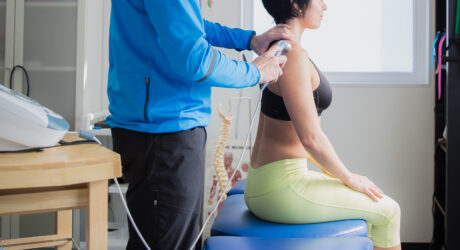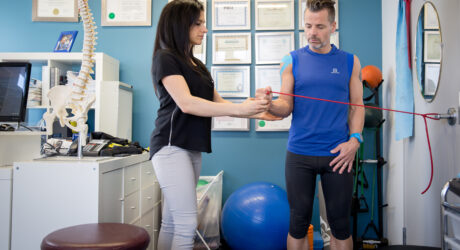
Ultrasound
#ultrasound
Ultrasound is a high frequency sound generator that is locally applied to injured or inflamed areas. Ultrasound causes micro-movement to tissues and has the ability to increase circulation, clean up congested areas and break down connective tissue adhesions.
Electrotherapy
#interferentialtherapy #tens
Electrotherapy is a therapeutic treatment that helps reduce pain and improve soft tissue healing. Electrodes are placed on the skin at the site of the injury and when the device is on, it creates several small electrical pulses that penetrate the tissues at the site of injury. As the pulses cross the skin’s surface, low frequency stimulation is created. This stimulation causes the body to produce endorphins and other natural substances that help reduce pain.
The majority of patients find electrotherapy to be very beneficial and describe the treatment as a sensation of small needles or tingling.
Benefits
- Reduces painful symptoms
- Decreases local edema
- Improves muscle tone
- Restores normal movements
- Enables the body to produce chemicals, such as endorphins that help to reduce our perception of pain.
- Accelerates the healing process
Thermotherapy
#heattherapy
Heat is generally recommended to relax spastic tissues and temporarily relieve the symptoms associated with chronic pain and muscle tension. The use of heat to calm spastic or chronically irritated tissue is a good way to increase flexibility, mobility and blood circulation, which ultimately speeds up the healing process.
Benefits
- Increases circulation
- Relaxes muscle tension
- Reduces joint stiffness
- Prepares the tissues for rehabilitation
Cryotherapy
#cryotherapy
Ice is often used for acute injury or during a recent exacerbation of a chronic malaise. Tissue cooling is effective in reducing and preventing post-traumatic edema. Local application of ice should be repeated several times a day when the injury is recent. For example, cryotherapy is an easy and effective way to reduce edema in inflamed tissue.
Benefits
- Helps reduce edema and inflammation
- Numbs the area to reduce pain
- Reduces muscle spasms
Prescribing therapeutic exercises
#exercisetherapy #rehab
After an injury, the scar tissue created changes the elasticity and strength of the muscles. It is therefore important to have a good stretching and strengthening exercise program established according to your needs, allowing you to restore muscle tone. Results take time. Exercise is an effective and inexpensive way to recover faster, stabilize the spine and peripheral joints, and help prevent relapse.
Benefits
- Improves range of motion
- Re-educates damaged muscles
- Strengthens the vertebral structure
- Promotes faster healing

Stretching exercises
- Ankle stretches (in French)
- Neck stretches (in French)
- Shoulder stretches (in French)
- Knee stretches (in French)
- Hip stretches (in French)
- Lumbar-sacroiliac stretches (in French)
- Thoracic stretches (in French)
Strengthening exercises
- Ankle strengthening (in French)
- Neck strengthening (in French)
- Elbow strengthening (in French)
- Shoulder strengthening (in French)
- Knee strengthening (in French)
- Wrist-hand strengthening (in French)
- Thoracic, lumbar and sacroiliac strengthening (in French)
- Core level 1 (in French)
- Core level 2 (in French)
- Core level 3 (in French)
- Rehab Calcific Tendinitis / Shoulder Impingement syndrome (in French)
- Postural exercise (in French)
- Fitness Ball exercise (in French)
Movement Amplitude
- MA knee-ankle (in French)
- MA hip-trunk (in French)
- MA wrist-hand-elbow (in French)
Knee Clinic
- Knee Clinic Level 1 (in French)
- Knee Clinic Level 2 (in French)
- Knee Clinic Level 3 (in French)
